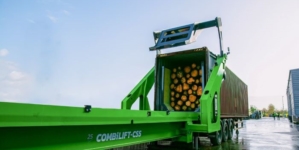-
ROSSLARE EUROPORT TARGETS HEALTH & SAFETY WITH CAMERA TELEMATICS PARTNERSHIP - July 25, 2024
-
Landmark Study Reveals Wearable Robotics Significantly Boost Safety and Efficiency in Industrial Environments - July 24, 2024
-
Visku Tackle The Retail Seasonality Challenge One Pallet At A Time - July 22, 2024
-
KAMMAC AND BERGEN LOGISTICS STRENGTHEN FASHION & LIFESTYLE SERVICES IN THE UK - July 19, 2024
-
TENTBOX EXTENDS PARTNERSHIP WITH ARROWXL TO SUPPORT INCREASING DEMAND - July 17, 2024
-
The Perfume Shop improves customer journeys while driving profitability in partnership with Scurri - July 17, 2024
-
ZEROMISSION SECURES £2.3M ($3M) INVESTMENT TO ACCELERATE ELECTRIC FLEETS - July 16, 2024
-
BCMPA CELEBRATES SUCCESS OF 2024 CONFERENCE - July 15, 2024
-
Best of the Best: Jungheinrich Celebrates Triple International Award Win - July 12, 2024
-
GOPLASTICPALLETS.COM CALLS ON NEW CHANCELLOR RACHEL REEVES TO CONSIDER PLASTIC PACKAGING TAX REFORM - July 10, 2024
VOICE CHOICE
Renovotec technical services director Lance Bennett provides some practical advice on Voice systems implementation and optimisation
Voice is not a panacea, but where it is the right solution for the job it can produce dramatic improvements in performance and accuracy. Increases in worker productivity of up to 35% and a reduction in picking errors to near-zero are common, with rapid payback as a result.
Where are voice solutions best deployed? Simply put, wherever its users benefit from working hands-free. A good example is high volume, small item picking (for example in an Internet sales fulfilment operation) where a voice-driven, hands-free system can deliver a significant increase in performance with optimum accuracy, reducing costly processing time.
Voice is also beneficial in lower volume environments where accuracy is essential such as the maintenance and inspection of high value assets (think aircraft, industrial plant equipment) and for complex component picking such as automotive assembly kits where there can be no room for error.
Once installed a voice system can be used for any transaction that is hands-free; for example in the warehouse a voice terminal can be used to manage forklift-enabled, hands-free pallet movements, freeing up space in the cab and obviating the need for drivers to look at in-cab computers.
But while voice has many uses its technology is not ideal for large data collection or non-numeric data handling. Care should be taken to understand what your voice inputs are to ensure they don’t slow down the process.
Be prepared
Getting the best out of a voice system requires careful preparation. After all this is no common or garden scanning system; voice is far more sophisticated. Voice systems are complex solutions that can easily fail if badly implemented. A consultative approach is essential, in which the supplier and their client focus on the workflows that have been identified as ideal candidates for voice support, analysing and optimising them in readiness for voice systems implementation.
We frequently recommend running a voice systems trial to ‘prove the benefits’.
As voice is sometimes accompanied by major changes in working practices it is best to avoid a ‘big bang’ approach in favour of (say) team-by-team voice adoption. This enables staff to participate in identifying any minor adoption difficulties and help address them – all of which eases the transition from old to new, and the introduction of improved methods.
There are basically three ways to install a voice system. One approach is to implement a point solution onto the client company’s WMS, usually via a direct connector to the warehouse management system. Beware however that direct connection can result in a more rigid implementation and a poorly matched workflow, depending on the WMS. Direct Voice-WMS integration can be a very good option when the WMS has open APIs that enable tailored voice workflows to be designed that reflect the optimum process flows.
Another approach is via screen-scraping, maybe used when an organisation’s WMS is remotely hosted and lacks voice or integration facilities. While it is viable, any screen scraping application will be restricted by the data that is presented by the underlying data screens.
Middleware – the third option for voice implementation – requires data integration between the host and the middleware. This solution normally gives far greater control and flexibility of workflow design and optimisation (without requiring changes to the host system/WMS). However, care should be taken to ensure that the chosen middleware does not restrict the functionality of the WMS by poorly duplicating functions or data.
Here an independent advisor can support the user by selecting and deploying the right solution for your operation.
Too often a voice system is implemented as a static solution and left to operate as it was installed, year after year – even though the business is continually changing. Once installed, keep your voice system optimised with an annual process review in line with business and process changes.
Voice has an exciting future, not only for the consumer but also for supply chain drivers such as robotics. It is a sophisticated and powerful technology that always rewards a respectful adopter.
A case in point:
VOICE PICKING TECHNOLOGY IN ACTION AT AO.COM
Following a trial at online-only retailer AO.com, Renovotec’s voice-picking project has now gone live across the company’s extensive UK logistics operation, where 120 voice-picking devices are being used. AO.com specialises in household appliances and electricals: conservative cost-benefit analysis shows that the new voice technology will achieve payback “well within a year” say Renovotec. The new voice-driven solution updates AO.com’s approach and ensures that the right goods are picked and loaded in the right sequence, delivering higher levels of speed, accuracy and performance.
The author can be contacted at: [email protected]

































